I once saw this beautiful ribonn-like marine creature in a magazine and I wanted to know more about them as soon as I saw them. As it turned out that ribbon-like animal is named as ribbon eel. Also, I learned that fish lovers always try to rear this unusual fish in aquariums. But can you rare them in an aquarium? The following guidelines help you to rear and care for Ribbon eels in your aquarium.
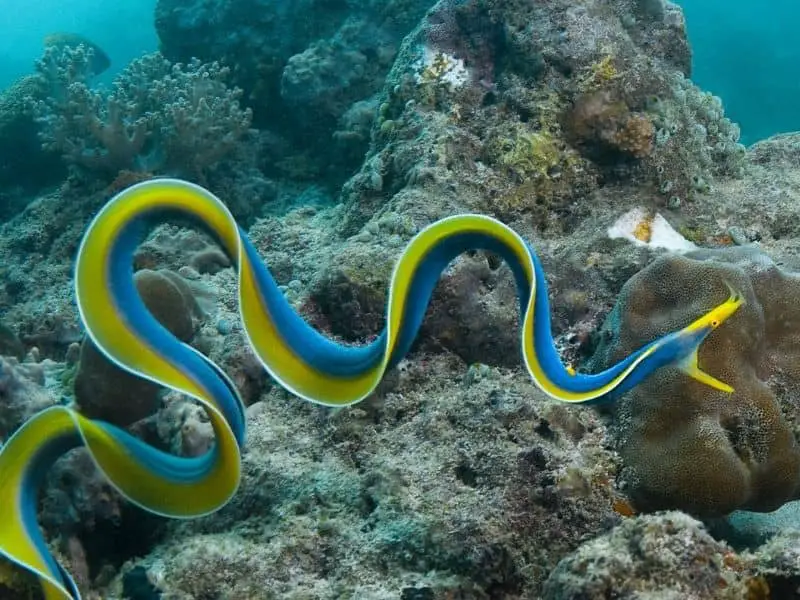
Unusual Ribbon eel (Rhinomuraena quaesita)
Jump To
- 1 Unusual Ribbon eel (Rhinomuraena quaesita)
- 2 What is a ribbon eel & Appearance?
- 3 What is the mouth and nostrils shape of ribbon eels?
- 4 What are the other names of The ribbon eel?
- 5 How big does a ribbon eel get?
- 6 The behavior of ribbon eel
- 7 Can you rear ribbon eels as pets?
- 8 Is ribbon eel aggressive?
- 9 Are ribbon eels dangerous?
- 10 Do ribbon eels bite?
- 11 Ribbon eel lifespan
- 12 Ribbon eel care in a reef tank or Aquarium
- 13 Are ribbon eels reef safe?
- 14 Ribbon eel tank size
- 15 How many ribbon eels should be kept together?
- 16 Tank setup
- 17 Ribbon eel breeding
- 18 How to feed ribbon eel?
- 19 What fish can live with ribbon eel in an aquarium?
- 20 Types of a ribbon eel
- 21 Related questions
Rhinomuraena quaesita (or ribbon eels, Yellow ribbon eel, Black ribbon eel, Leaf-nosed moray eel, or Berni’s eel) belongs to the Genus of Rhinomuraena. The ribbon eel is the cousin species of the moray eel. Ribbon eels can be found in coral reefs and lagoon areas of the Indian and Pacific regions. Moreover, this laterally compressed marine water eel variety has carnivorous feeding behaviors. Thus, they rely on small crustaceans, insects, fish, and other saltwater animals. They are definitely a good addition to your aquarium
They are mostly associated with shallow waters and deep waters up to 60m. Generally, you have to dive into the ocean to see ribbons eels, because they are buried in cavities of the reef. IUCN conservation included ribbon eels in the “Least Concerned” category.
What is a ribbon eel & Appearance?
The ribbon eel or Blue ribbon eel is a marine water animal that has a fascinating life cycle. Their body is long, thin, and laterally compressed like a Ribbon. That’s why they got this common name. They also have continuous pelvic and dorsal fins on their body. The ribbon eel does not have scales like other eel varieties. Further, they do not have bony plates over their gills. They can easily identify from the anterior nostrils.
The most interesting thing is all Ribbon eel start their life as male eels. But when they become mature they change their gender to a female eel. These types of animals are called Protandric hermaphrodites. Furthermore, they change their color completely in three different age phases.
Juvenile Stage
It is also called the “Black Phase”. Ribbon eels start their life as black color juveniles with a bright yellow dorsal fin. This fin continuously goes on their black color body.
Male Stage
This stage is also called the “Blue phase”. When ribbon eels mature, they change their black color into a bright electric blue color. They also have a vivid yellow dorsal fin. In this phase, matured male ribbon eels have 2- 3 feet lengthy bodies.
Female Stage
This stage is known as the “Yellow Phase”. The male stage of the ribbon eel grows continuously and when its size reaches up to 1.3 meters (4 feet) the electric blue color turns into yellow color. In this phase, ribbon eels develop female reproductive organs in their body. After they turn into a female eel, they can lay eggs.
What is the mouth and nostrils shape of ribbon eels?
Ribbon eels have two long protruding nostrils and those function as a sensor. Nostrils can identify vibrations of water and it helps them to hunt prey and protect from predators. They have a highly expandable mouth with two jaws.
What are the other names of The ribbon eel?
The ribbon eel is also called Yellow ribbon eel, Black ribbon eel, Leaf-nosed moray eel, or Berni’s eel. They got this name because of their ribbon-like body shape.
How big does a ribbon eel get?
They maximally grow up to around 1.3 meters (4 feet) in length in their native habitat. This can vary with your tank space, water condition, and care.
The behavior of ribbon eel
Naturally, they inhabit the sandy bottom of the ocean and try to hide in coral reefs and sandy substrates. Mostly they keep their head area outside of the cave or hole. Male ribbon eels do not have territory and also, and they spent years of their life in the same place. Because ribbon eels do not like to change their habitat from time to time. Another thing is, Juvenile ribbon eels also can swim.
In the aquarium, they show the same hiding behavior and try to swim around rocks. They can open their mouth widely with their jaws. Moreover, they have razor-like tiny teeth on their jaws. They always open and close their mouths for breathing. Some people think the Ribbons eels are aggressive fish due to this behavior.
Can you rear ribbon eels as pets?
Yes, you can rear this colorful and unique creature in your saltwater aquarium as a pet. But if you do not pay much attention to them, they will not live more than one month in captivity. Therefore, you should have to create an aquarium with ideal water quality parameters such as temperature, pH, and Salinity. Because of saltwater species, they cannot rear in freshwater. Thus, you should provide saltwater with the correct salinity level to grow eel healthy.
Is ribbon eel aggressive?
Yes, they are categorized as semi-aggressive animals. They always open their large and wide mouth for breathing purposes. And also their tiny razor-like teeth expose to the outside when they open their mouth. People misunderstand it and they think ribbon eels are aggressive and dangerous. But most of the time they are scared of foreign and unfamiliar things. When they feel some threat, they hide in the hole or cave of the coral reef.
Further, you can take some precautions to minimize their aggression level. They are always seeking a hiding place. Hence, you can provide a PVC pipe that has a 1.5 -2 diameter size in the aquarium. It will help to reduce the stress and aggressive behavior of ribbon eel.
Are ribbon eels dangerous?
No, generally they are peaceful animals and can live with other saltwater species. But if you feed them by hand, accidentally they will bite your hand. Because ribbon eels have poor vision. Hence, feed them using the stick. Their mouths are expandable and they always open their mouths for breath. Some fish lovers consider them dangerous animals as a result of this breathing behavior.
Do ribbon eels bite?
Yes, they will bite your hand, if you are going to feed them using your hand. Their eyes are not well developed. Thus, they will accidentally bite your hand using their razor-like tiny teethers. Thus, you will feel pain.
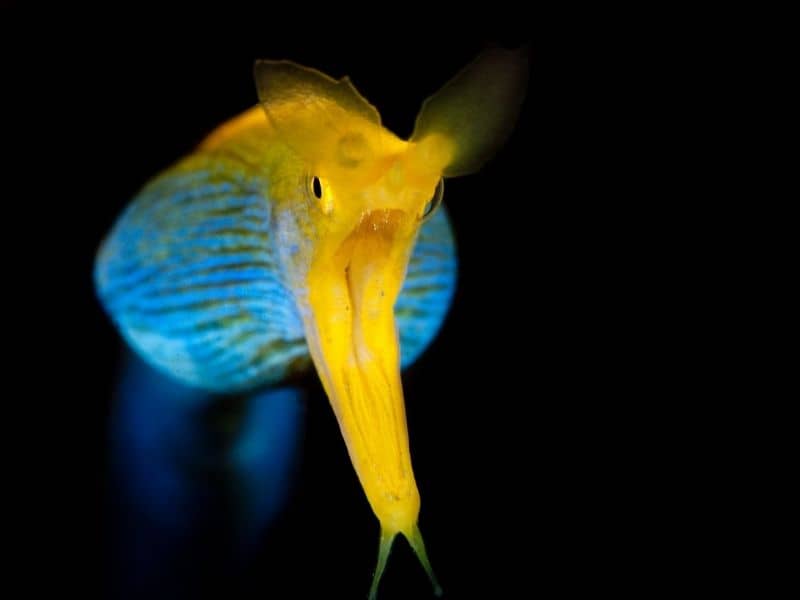
Ribbon eel lifespan
Ribbon eels have a relatively long life span. They can live around 18-20 years in their native habitats. But in captivity, their life span can change. Most of the time they do not live more than one month in captivity. But if you care for them properly, you can rear this amazing creature for a long period.
Ribbon eel care in a reef tank or Aquarium
You should focus on the following factors carefully to rear them healthy. Arrange a tank that has a 40-gallon capacity or more. You must prepare a bit of a dark zone with corals or stones in your aquarium to hide them. Because they prefer moderate light conditions and always try to hide in the dark zones
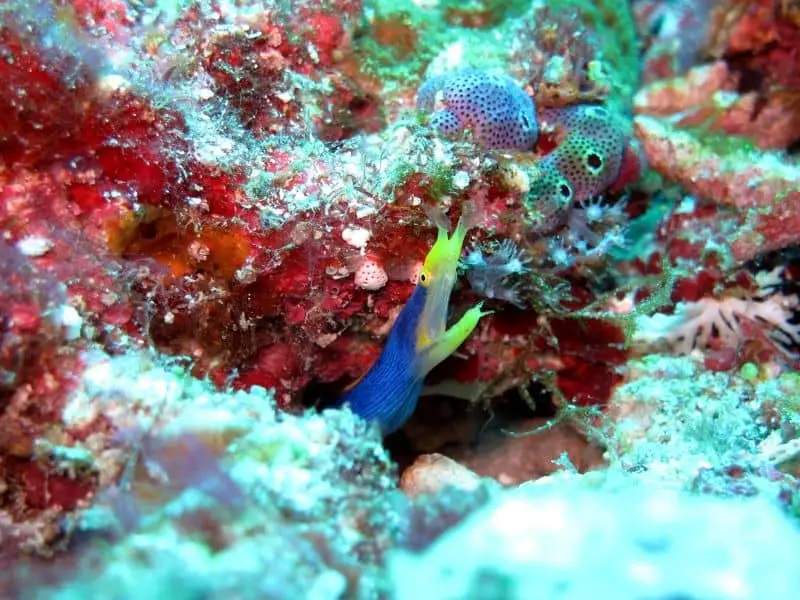
Are ribbon eels reef safe?
Yes, coral reefs provide lots of hiding grounds to ribbon eels. The coral reef is a large live structure that consists of millions of tiny organisms. Further, it has lots of cavities, caves, holes, and hiding places. Ribbon eels always try to hide their body in cavities. For that reason, coral reefs provide a safe environment for them.
Ribbon eel tank size
You must have at least a 40 gallons tank because they have long elongated bodies. Further, ribbon eels always try to hide in caves, cavities, and holes. Therefore, you should create that type of environment in the aquarium. You can use coral practicals, stones, and some ornaments that facilitate places to hide.
How many ribbon eels should be kept together?
Kept a pair of Ribbon eels in a 75 gallons tank. It is more comfortable for them. Moreover, you can keep other eels like White ribbon eels, Spotted snake eels with them.
Tank setup
| Category | Rating |
| Care Level: | High (expert level) |
| Temperament: | 78 – 82 Fahrenheit |
| Salinity | Between 1.020-1.025 |
| pH | 8-8.5 |
| Color Form: | Blue, Yellow, Black |
| Lifespan: | 18-20 years in wild |
| Size: | 3-4 feet (1.3m) |
| Diet: | Carnivorous (rely on animal matters) |
| Family: | Muraenidae |
| Minimum Tank Size: | 75 Gallons |
| Tank Set-Up: | Saltwater with plants and caves |
| Compatibility: | Species tank or peaceful community |
Ribbon eels are extremely sensitive to the external environment. Thus, you must put attention to the tank setup preparation. Once you release a ribbon eel to the aquarium or tank, it must feel that like a home. If not they will refuse to eat and will die immediately. Please follow the below guidelines when you are preparing the tank setup.
- Set up 75-80-gallon tank for ribbon eel pair
- Add PVC pipes that have a 1.5-2-inch diameter and place them just below the sand substrate. Because it gives a safe home to eel fish to hide.
- Add coral parts and other ornaments to create some natural habitat feeling
- Ribbon eels spend most of the time on the bottom of the tank. Thus, you should install a good filter to oxygenate the bottom level water of the tank
- They always try to hide in caves and holes. Hence, you should prove a bit darker part of the tank for them to associate. Therefore, you should arrange aquarium light conditions according to it
- Use an aquarium heater to maintain steady temperatures.
- Add a Ribbon eel pair to the aquarium
Water quality condition
Ribbon eels require pristine water. Therefore you must maintain water quality at a high level in the aquarium. It should be free from ammonia, nitrates, and nitrites.
Salinity Level
It is the key important factor. Because they cannot survive in freshwater. Thus, you must use aquarium salts to maintain the salinity level of the water. Add half a cup of aquarium salt per one gallon of water. The salinity level should be between 1.020-1.025. You can measure salinity level using a portable salinity meter.
pH level
You should maintain pH in between 7-8 to rear healthy eels in your aquarium.
Water Temperature
Keep your temperature between 72-78 Fahrenheit. You can use an aquarium thermometer to control the water temperature steadily.
Water Hardness
Water hardness should be between 8-12dKH.
Filter System
Ribbon eel needs water that is free from ammonia, nitrate, and nitrites. Therefore, you should install a good filter system in your aquarium. Further, change 20% of the water every week and replace it with portable water, and add aquarium salt to maintain the salinity level.
Special tips
Ribbon eels have poor vision. Thus, they use the sensation of the nostril to capture the prey. If you feed them by hand they will eat your hand because of their poor recognition ability. Thus, train them to feed them using a stick.
Ribbon eel breeding
In the natural environment, mature male and female eels mate when the water temperature is warm. Male and female eel encounter for mating and female ribbon eel lay hundreds of leaf-shaped eggs. Before hatching, these eggs are floating in the ocean for 8 weeks.
Identify female ribbon eel
You can easily distinguish female ribbon eels by their body color. Females have yellow body color with yellow color dorsal fin and male eels have an electric blue body with a yellow color dorsal fin. Female ribbon eels are larger than male ribbon eels. They are protandric hermaphrodites. All ribbon eels start their life as male eels and if there is no female eel present, the dominant male metamorphoses to the female eel.
Ribbon eel male vs. female differences
| Male Ribbon Eel | Female Ribbon Eel |
| Smaller in size than female | Larger than male |
| Electric blue color body | Yellow color body |
| Grow up to around 3 feet | Grow up to around 4 feet |
How to breed
Normally they can capture from the wild for ornamental purposes. The ribbon eel’s breeding procedure is very complex and needs expert knowledge to breed them in captivity. But most of the time breeding is not successful in the aquarium. Because they need exactly the same parameters of natural habitat to breed in captivity. But, if their breeding requirements are accomplished, in large tanks, they will breed. Those are;
- Male and female ribbon eels
- A tank that consists of corals and other hiding grounds
- Low-intensity light condition
- Warm water
How many babies does ribbon eel have?
Generally, ribbon eels lay around 300 leaf-shaped eggs. This egg’s overall size is around 4 mm. These eggs are floating on the water. After 8 weeks, the eggs hatch, and fry eels are released into the water.
How to care for the fry
Ribbon eels’ eggs hatch into a flat and transparent larva stage. That larva was named leptocephali. In the natural habitat, larvae drift on the surface waters of the ocean and feed on dissolved nutrients. When they grow up, they are known as the “Elver”. In the aquarium, you can provide brine shrimp to feed them.
How to feed ribbon eel?
They are carnivores. Hence, small live fish and crustaceans are their favorite foods. You should pay high attention to the food when they are in captivity. Because they refuse food in captivity. Firstly, you can provide live small fishes such as guppies, zebrafish, mollies, damselfish, fathead minnows, crustaceans such as ghost shrimp, and fire shrimp as food. They can use their clamped nostril to attract prey and hunt prey using their strong jaws.
Gradually, train your ribbon eel to eat meat particles such as shrimp, fish, and squid particles. They prefer marine water meat. It recommends giving food particles by a stick. You have to practice it. Do not feed ribbon eel by hand. Because they have bad vision and they cannot identify your hand. If their razor-like tiny teeth touch your hand, you may feel pain.
What does ribbon eel eat in the Wild?
Most of the time ribbon eels live in cavities or holes of the coral and only their heads are visible to the outside. They get sensation from their nostrils and hunt prey. They also identify predatory activities by their nostrils sensations. Generally, they do not like to change their habitat. Thus, they live in the same habitat for a long period. In the wild, they hunt small fishes and crustaceans as their feed. Female and male eels mate in the seasons when the water temperature becomes warm. Generally, they mate in summer. Females lay hundreds of leaf-shaped eggs and those float on the ocean water.
What to Feed ribbon eels in the Aquarium?
First, you must provide live foods to ribbon eels until they adapt to captivity. You can give live guppies, molly, small goldfish, and squid to them. Then gradually you must train them to feed meat particles. You must use a stick to feed them with meat particles.
How long can ribbon eel go without food?
They can live for 2 weeks without eating food. But it is not good practice for a healthy eel. Thus, you should provide live food for them at at least 3 days intervals.
When to feed?
You can add a group of live animals such as guppy, molly, and ghost shrimp into the aquarium. Then they can hunt live fish when they feel hungry. If you train them to give meat particles by stick, feed them at least one time per day.
How much to feed
Normally they eat one or two small fish as one diet. Thus, you should provide that much of a diet for them.
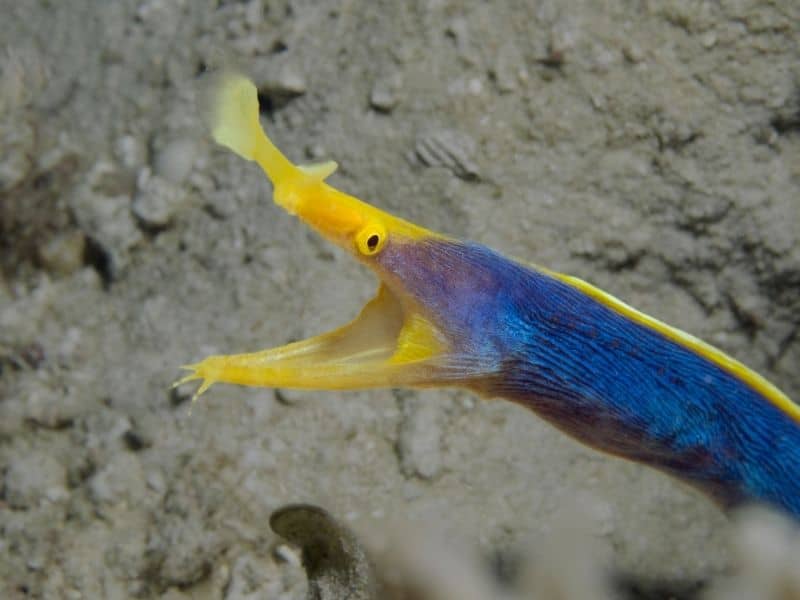
What fish can live with ribbon eel in an aquarium?
Ribbon eel eats any creature that suits their moth. Thus, do not add small fish and invertebrates with them. Large reef fish are most suitable to rear with ribbon eels. Do not keep ribbon eels in the same home as other moray eel species.
Good Tank Mates for Ribbon Eels
- Angelfish
- Larger Clownfish
- Rabbitfish
- Tangs
- Lionfish
- Groupers
- Other deep-bodied community fish
Poor Tank Mates for Ribbon Eels
- Damselfish
- Small Clownfish
- Gobies
- Firefish
- Cardinalfish,
- Small Shrimp
- Other fish small enough to be eaten
Will ribbon eels eat cleaner shrimp?
Yes, ribbon eel eats cleaner shrimp. They are carnivores and they will eat animals that fit their mouth. Well-grown cleaner shrimp have 4-5 cm widebodies and they are inhibited in coral reef ecosystems. In the aquarium, if the shrimp size is fitted to the ribbon eel mouth, it has a high possibility to eat cleaner shrimp.
Ribbon Eel predators
There are not many predators for ribbon eels. But other moray eels, barracudas, large groupers, and humans are the major predators.
Types of a ribbon eel
Blue ribbon eel
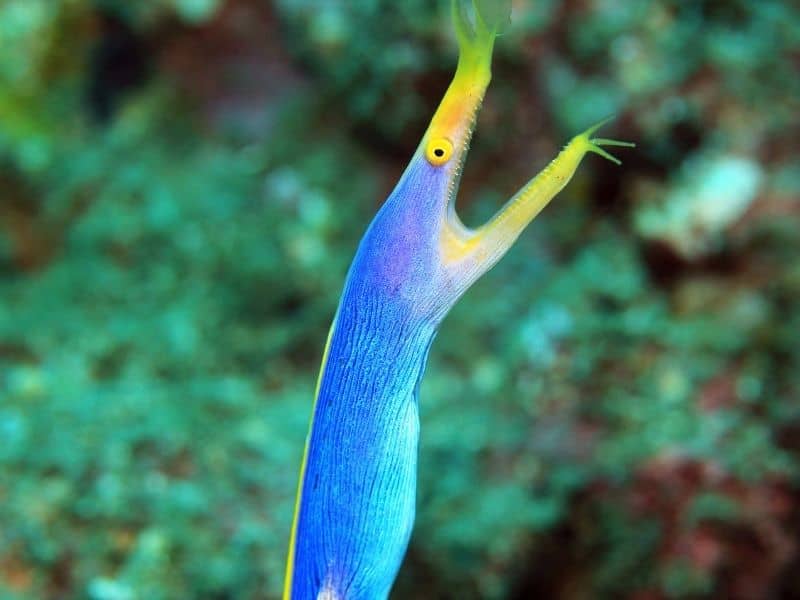
The Blue Ribbon eel (Rhinomuraena quaesita) is one of the most attractive underwater creatures. They have electric blue color laterally flattened body with a yellow color continuous dorsal fin. Because of their long elegant bodies and tiny dragon heads, they can distinguish themselves from other eels. Their undulating swimming pattern, body color, and shape make them a favorite saltwater species in the aquarium industry.
Ghost ribbon eel or white ribbon eel
The ghost eel is also called the white ribbon eel. Their whole body is white and has black spots on their head and faces. Their body color turns light brown with age. This Ghost ribbon eel is closely relative to Blue and Black ribbon eels. They are hidden in coral caves in the daytime. Thus, commonly you can see them at night time in their natural habitat. They can reach 4 feet in length. It is easier to rear in a saltwater aquarium than a Black or Blue ribbon eel. The 50-gallon tank with coral structures is ideal to rear this eel. Further, you can use small crustaceans such as ghost shrimp as their food.
Black ribbon eel
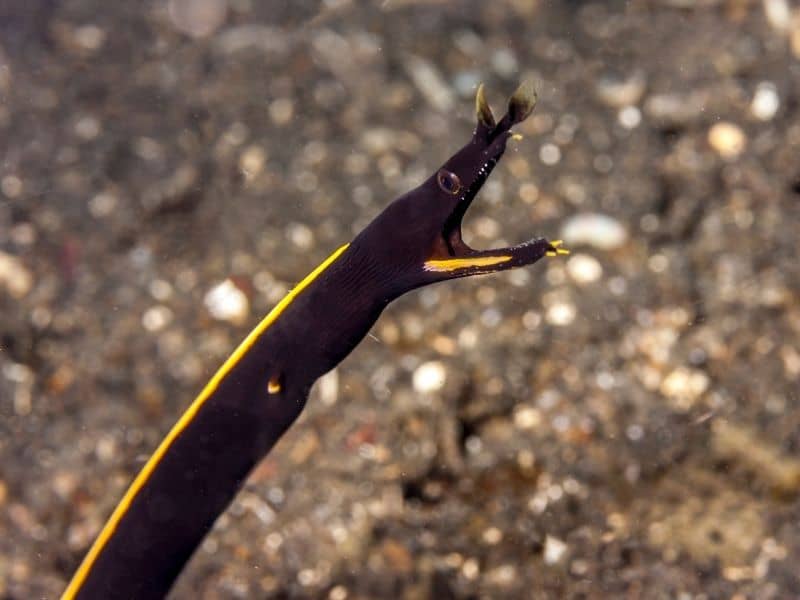
The Black Ribbon Eel (Rhinomuraena quaesita) is also called blue ribbon eel or yellow ribbon eel. They have an elongated black color body and a continuous yellow color dorsal fin on their body. The early stages of ribbon eel life have black color elongated body. With age, their color changes into blue and then yellow. Black eels also have laterally flattened body shapes and hide in the caves of coral habitats. Ribbon eels only eat if the surrounding is comfortable for them.
Related questions
Does ribbon eel eat plants?
No, they are not. They are carnivorous marine species. Thus, they only eat live animals and meat matters. They do not eat plant matter.
Are ribbon eels rare?
Yes, ribbon eels are pretty rare, because they spawn only in the summer of the year. They need warm water conditions to breed.
Why is eel blood toxic?
Eel blood includes a poisonous chemical that adversely affected humans and mammals. This toxin protein can cramp muscles including heart muscles. A small amount of eel blood is enough to kill a person. Therefore do not eat raw eels. Properly cooked eel meat can be used as food. The toxin proteins are unfolded with the temperature when you cook them.
How much is a ribbon eel worth
According to the body length, their price varies.
| Size | Price |
| Small size ribbon eel : 8-14 inch | $100 |
| Medium size ribbon eel : 14-20 inch | $160 |
| Large size ribbon eel : 20- 26 inch | $180 |
How to Catch a Ribbon Eel?
Most people try to catch them by hand or net. But it is a bit difficult to catch them safely from their natural habitat. Because when they see foreign material, they immediately hide in the cavity or holes that they naturally occur. Some divers use cyanide to flush out ribbon eels from the caves. But if divers can wait until a few hours, ribbon eels will become familiar with the diver and come out from the caves.
Can a ribbon eel kill you?
Yes, if you eat raw meat of ribbon eel, it may kill you. Because their blood contains some toxic proteins that cause them to kill you. If you want to eat ribbon eel, cook it properly. Because higher temperatures denature the toxic protein and destroy the toxic function.
Read more: Diamond Tetra must know care facts, Behavior, breeding
